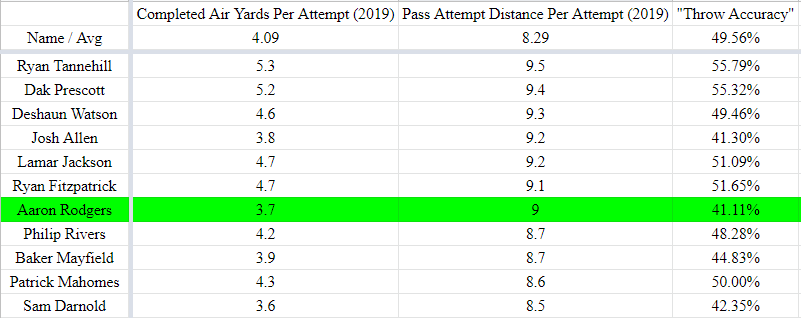I recently polled the fantasy football community on Twitter, asking whether they thought Aaron Rodgers would be a top-12 fantasy quarterback in 2020. Last season, Rodgers missed out on accomplishing this feat by finishing No. 13 among qualified quarterbacks with 17.0 Fantasy Points per Game; his lowest mark since he took over at quarterback for the Green Bay Packers back in 2008.
Poll time! Will Aaron Rodgers finish as a top-12 QB in 2020? Please vote and retweet! I would like as many votes as possible #fantasyfootball
— Aaron Stewart (@ffbcaptain) July 17, 2020
The results of the poll showed more optimism than FantasyPros’ 2020 expert consensus ranking of QB13. Fantasy football players must accept that Rodgers is no longer a QB1 in fantasy; he is now a streaming option and, likewise, a fade in drafts.
Matchup Dependent
Aaron Rodgers no longer finishes as a QB1 on a consistent week-to-week basis. The 2019 season showed that the top QB1 scorers finished in the top-12 at the position at least 50-percent of the time.
https://twitter.com/amrgaabr/status/1287769549316788224
According to Pro Football Reference, Rodgers went against five defenses in 2019 that ranked in the bottom half of fantasy points allowed to quarterbacks. He produced a top-12 weekly performance in four of those five games. In the other 11 games, against teams ranked in the top half of fantasy points allowed to quarterbacks, he produced a top-12 weekly performance only twice. Six top-12 weeks for a QB in 16 games puts Rodgers closer to streaming status than bounce-back candidate status. Matthew Stafford is the only quarterback drafted before Rodgers in 2020 with fewer top-12 weeks in 2019; Stafford had five top-12 weeks despite playing only eight games.
Passing Opportunity
The passing volume is trending in the wrong direction in Green Bay. In the first year of Matt LaFleur’s head coach tenure, Aaron Rodgers saw his pass attempts per game decrease by 1.7 and his Adjusted Yards Per Attempt decrease by 0.3 yards despite similar touchdown/interception ratios (26:4 in 2019, 25:2 in 2018). The decrease in volume and shorter pass distance cost Rodgers 440 passing yards compared to the 2018 season and he narrowly avoided missing the 4,000-yard mark, finishing with 4,002 (No. 11) passing yards.
Check out Aaron Rodgers’ 2020 Projection on PlayerProfiler’s “World Famous” Draft Kit:
Despite the decrease in overall pass volume, Rodgers finished top-5 with 85 (No. 4) Red Zone Attempts, 94 (No. 2) Deep Ball Attempts, and 34 (No. 1) Money Throws. It’s alarming that the high volume in high-leverage fantasy point-scoring situations did not get Rodgers into the top-10 at his position. These volume stats were also higher in 2019 than they were in 2018, when Rodgers had 73 (No. 10) Red Zone Attempts, 87 (No. 2) Deep Ball Attempts, and 19 (No. 16) Money Throws. It is illogical to expect an increase in these stats in 2020.
Passing Efficiency
Aaron Rodgers’ passing efficiency in 2019 was concerning. Red Zone Completion Percentage was his only top-20 stat among qualified quarterbacks in 2019. His 60.0-percent (No. 17) mark is average among NFL quarterbacks though. He barely finished inside the top-30 with a 61.0-percent (No. 29) Play-Action Completion Percentage, and his 32.2-percent (No. 25) Pressured Completion Percentage does not evoke confidence in his ability to be a dependable fantasy QB1 in 2020. The most alarming decline in his game, his Deep Ball Completion Percentage falling to 34.0-percent (No. 22), is not discussed enough among fantasy football players. Let’s take a deeper look into Rodgers’ declining arm strength.
Quarterback Advanced Stats
Any quarterback comparing to Josh Allen in a passing category should be cause for alarm among fantasy football players.
https://twitter.com/aaronstew09/status/1285218791698370563
Using PlayerProfiler’s Data Analysis Tool, I created a table for quarterbacks that tracked their Completed Air Yards Per Attempt and yards of Pass Attempt Distance Per Attempt. Below is a screenshot of a table that shows quarterbacks that averaged similar yardage totals of Pass Attempt Distance Per Attempt.
It’s important to define what the “Throw Accuracy” column in my chart means. First, Completed Air Yards discounts yards after the catch; it’s the amount of yards the ball travels in the air. Throw Accuracy is a ratio of Completed Air Yards Per Attempt to Pass Attempt Distance Per Attempt; it should be used to compare players with similar Pass Attempt Distances Per Attempt. Quarterbacks with short Pass Attempt Distances (i.e. Drew Brees and Jimmy Garoppolo) have higher Throw Accuracy marks because slants and other shorter passes are completed more than vertical routes.
Sam Darnold, Philip Rivers, and Baker Mayfield are three quarterbacks that struggled with arm strength and accuracy last season. It’s laughable when people mention them in the fantasy QB1 conversation for the 2020 season. Looking at the chart, why is Aaron Rodgers not held to the same standard? Fantasy football players need to look past the name recognition and realize that Rodgers, in 2020, doesn’t have the arm strength to make the throws he made when he dominated fantasy football during the 2009-2016 seasons.
Declining Rushing Production
This past season, Aaron Rodgers averaged 11.44 rushing yards per game, which was the lowest in his starting quarterback career. His 3.98 yards per carry was more than a full yard less per carry than he averaged in the last six years. An increasing list of injuries accrued throughout his career has not helped either. Back-to-back seasons with knee sprains, a concussion in 2018, and two clavicle fractures make it difficult for a quarterback approaching age 37 to dive into the end zone.
Surrounding Talent
Entering the 2020 offseason, it appeared that the plan for the Packers was simple after finishing 13-3: get Aaron Rodgers more offensive weapons. Most Rodgers enthusiasts point out that his wide receivers in 2019, outside of Davante Adams, were bad. With 17.6 (No. 6) Fantasy Points per Game, Adams was a bright spot in the receiving game.
Last season, a popular debate was who between Marquez Valdes-Scantling and Geronimo Allison would become Rodgers’ No. 2 receiving option. The answer? Allen Lazard, I suppose. The truth is the No. 2 receiver was a constant revolving door of players. That’s why the Packers should have addressed the need with pick No. 26 in the NFL Draft. They did not, and they are now one Devin Funchess injury away from Rodgers having the same No. 2 and No. 3 wide receivers as last season.
Conclusion
At 37 years old, Aaron Rodgers is in decline. His arm is no longer elite and his rushing production has diminished to average in the NFL among quarterbacks, ranking No. 16 last year with 183 rushing yards. These two traits are what made Rodgers an elite fantasy quarterback option in fantasy football. Without these traits Rodgers is, at best, a streaming option.
https://www.youtube.com/watch?v=W4cqKEOzuno
With an FFPC ADP right outside the top-100 players, don’t fall for the name recognition. His name will get him drafted and he won’t be on the waiver wire during the season. Rodgers is no longer a starting quarterback in fantasy football leagues. Don’t draft him as a QB1. Let the competition pick him up believing in the façade of him being a “safe” QB1 option.



